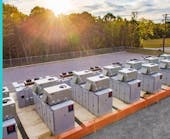Convergent Li-Ion Battery system helping decarbonize, cut costs at Ford Engine Plant in Canada
Ford Motor Co. has strengthened its commitment to electric vehicle production over the past year, separating its EV division from the internal combustion side and also announcing moves to expand its battery cell supply chain.
The historic automaker is even using the same technology often used in EV batteries to help decarbonize its assembly plant operations in Ontario, Canada.
Energy storage supplier Convergent Energy and Power has deployed lithium-ion capacity at the Essex Engine Plant in Windsor, Ontario. The array helps support Ford’s electricity needs with a 4-MW/8-MWh battery energy storage system (BESS) already in operation.
The energy storage helps decarbonize and defray utility costs during peak demand periods with rates can be higher and need stronger. Convergent’s BESS utilizes artificial intelligence (AI) to deploy smart energy solutions and reduce the Ford plant consumption, costs and carbon footprint, according to the companies.
“The battery storage system provided by Convergent Energy and Power is a strong example of how batteries can support the auto industry at the plant level while also supporting the electric grid serving Ford and the surrounding community,” said Thomas Reeber, Plant Manager at the Ford Essex Plant, in a statement.
More from EnergyTech
Ford details new, expanded Battery Cell Supply Chain moves
Assembly line begins rolling for Volkswagen ID.4 Electric SUVs in Tennessee
Ford has publicly vowed to transition to electrification of its automobile lines, but the Convergent BESS at the Essex Engine Plant is one of the first on-site battery arrays for the automaker.
Lithium-ion is a predominant element for both utility-scale energy storage and EV batteries, although Ford currently uses nickel cobalt manganese for much of its battery chemistries.
This summer Ford announced several new and expanded sourcing initiatives for battery capacity and raw materials to overcome global supply chain challenges.
Ford has set a goal to produce 600,000 electric vehicles annually beginning next year and two million per year by the end of 2026.
Ford also said it has secured all of the annual battery cell capacity—or about 60 GWh—needed to meet its 600,000 EV run rate goal.
The company also will add lithium iron phosphate (LFP) chemistry to its battery cell portfolio.
-- -- --
(Rod Walton, senior editor for EnergyTech, is a 14-year veteran of covering the energy industry both as a newspaper and trade journalist. He can be reached at [email protected]).
Follow us on Twitter @EnergyTechNews_ and @rodwaltonelp and on LinkedIn





